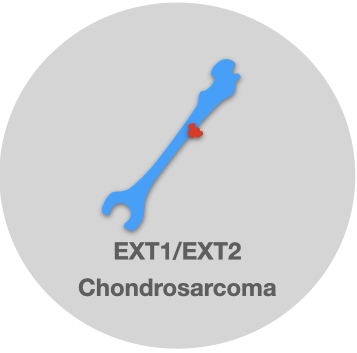Evidence for associations of EXT1/EXT2 Gene Mutations and Chondrosarcoma: A Review of Medical Genetics Studies.

Introduction
The EXT1 and EXT2 genes have long been recognized for their association with hereditary multiple exostoses (HME), a genetic disorder characterized by the presence of multiple benign bone tumors called osteochondromas. However, recent medical genetics studies have revealed a fascinating twist in this association, as some individuals with EXT1/EXT2 mutations have shown a propensity to develop chondrosarcoma, a malignant cartilaginous tumor. This transformation has garnered significant attention in the scientific community, prompting further investigation into the underlying mechanisms and clinical implications. In this review, we present a compilation of relevant studies that establish the link between EXT1/EXT2 gene mutations and the development of chondrosarcoma, providing valuable insights into the genetic basis of this rare but significant malignancy.
Individual patient or one family studies
| Patient/Family | Gene/Variation | Clinical Characteristics | HGVS(es) | Citation |
|---|---|---|---|---|
| Large multigenerational family with EXT and one family member with chondrosarcoma | EXT2 gene with loss of heterozygosity (LOH) for chromosome 8 and 11 markers | One family member had Chondrosarcoma. | - | PubMed |
| A large Chinese family with hereditary multiple exostoses | Deletion of a G in exon 3 of EXT2 gene | Chondrosarcoma occurred after either an operation or injury of the exostosis | - | PubMed |
| A 40-year-old man with hereditary multiple exostoses (HME) | No mutations found in EXT1 and EXT2 genes or exons 5-8 of p53 gene | Underwent resection of osteochondroma with the malignant transformation towards secondary peripheral chondrosarcoma and intermediate grade osteosarcoma (grade II/IV) found in the osseous stalk of osteochondroma | - | PubMed |
| Family with isolated chondrosarcomas, mostly located in ribs | Germline EXT2 mutation | Development of isolated malignant cartilaginous tumors including central tumors, absence of multiple osteochondromas (MO) | NM_207122.2(EXT2):c.138G>A (p.Trp46Ter) | PubMed |
| A seven-generation family from western Sweden consisting of 170 blood relatives, 38 of whom had multiple cartilaginous exostoses, while 8 had isolated exostoses. | EXT2 mutations. | All carriers of the detected mutation had multiple exostoses, indicating full penetrance. None of the pedigree members with isolated exostoses were carriers of the detected mutation. Two mutation carriers developed chondrosarcoma yielding a 5.2% risk of malignant development for this mutation. | NM_207122.2(EXT2):c.112_113del (p.Ile38CysfsTer17) | PubMed |
| A family with multiple hereditary exostoses | Risk for malignant transformation to chondrosarcoma and genetic mutations | 8.3% risk for malignant transformation to chondrosarcoma in this family | Exon 6 skipping | PubMed |
Cohort or multifamily studies
| Cohort | Setup | Outcome | HGVS(es) | Citation |
|---|---|---|---|---|
| Sporadic and hereditary osteochondromas and secondary chondrosarcomas | EXT1- and EXT2-mutation analysis, loss of heterozygosity, DNA ploidy | Two patients with multiple osteochondromas demonstrated a germline mutation combined with loss of the remaining wild-type allele in three osteochondromas. | NM_000127.3(EXT1):c.117A>G (p.Glu39=) NM_000127.3(EXT1):c.490G>C (p.Asp164His) NM_000127.3(EXT1):c.702_717del (p.Ile234MetfsTer13) NM_000127.3(EXT1):c.947A>G (p.Asn316Ser) |
PubMed |
| 42 HME French families | Mutation analysis of EXT1 and EXT2 genes | EXT1 and EXT2 accounted for more than 90% of HME cases; 31/36 mutations expected to cause loss of protein function (86%); EXT1 mutations associated with most severe forms of disease and malignant transformation of exostoses to chondrosarcomas | NM_207122.2(EXT2):c.680A>T (p.Asp227Val), NM_000127.3(EXT1):c.1746G>A (p.Trp582Ter), NM_000127.3(EXT1):c.1018C>T (p.Arg340Cys), NM_207122.2(EXT2):c.679G>A (p.Asp227Asn), NM_207122.2(EXT2):c.514C>T (p.Gln172Ter) | PubMed |
| 172 individuals (78 families) with hereditary multiple exostoses | Prospective genotype-phenotype study using molecular screening and clinical assessment to compare the severity of disease and the risk of sarcoma. | EXT1 and EXT2 mutations were almost equally common and identified in 83% of individuals. One sarcoma developed in an EXT2 mutation carrier, compared with seven in EXT1 mutation carriers. | - | PubMed |
| 20 chondrosarcoma cases (12 primary, 3 secondary to osteochondroma, 2 secondary to enchondromatosis, 2 extraskeletal ordinary, and 1 clear cell) and five cell lines. | Mutation analysis of the EXT1 and EXT2 coding regions. | Two missense mutations in EXT2 (D227E and R299H) were detected among the chondrosarcoma cases. | NM_207122.2(EXT2):c.896G>A (p.Arg299His), NM_207122.2(EXT2):c.681T>G (p.Asp227Glu), NM_207122.2(EXT2):c.681T>A (p.Asp227Glu) |
Conclusions
Traditionally known for their involvement in hereditary multiple exostoses, the EXT1 and EXT2 genes have been found to play a role in the transformation from benign osteochondromas to malignant chondrosarcomas. The evidence tables above provide a collection of medical genetics studies investigating the association between EXT1/EXT2 gene mutations and chondrosarcoma development. These studies have identified various EXT1/EXT2 mutations, loss of heterozygosity, and other genetic alterations associated with the development of chondrosarcoma. Further research in this field holds promise for improving the diagnosis, risk assessment, and management of chondrosarcoma in individuals with EXT1/EXT2 mutations, ultimately leading to better patient outcomes.